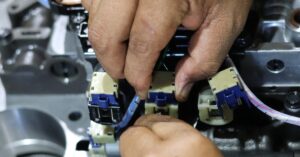
Latching solenoid valves are vital in modern tech applications to maintain position without power. Unlike traditional valves that need continuous power, they use a magnetic latch to stay in place. This functionality conserves energy and enhances system efficiency. Learn more about these valves with our quick guide on what you should know about latching solenoid valves.
How Latching Solenoid Valves Work
When activated, an electrical current flows through the coil, generating a magnetic field that moves the plunger. Once in position, the magnetic latch holds the plunger without requiring additional power. Key components such as the coil, plunger, and spring work seamlessly to achieve this efficient function.
Compared to traditional solenoid valves, which require constant electricity to maintain their state, latching solenoid valves offer energy conservation. This innovative solenoid design allows for more sustainable and cost-effective applications.
Advantages Over Traditional Solenoid Valves
Latching solenoid valves outperform traditional counterparts in several ways. They excel in energy efficiency, only needing power during the switching process. This feature significantly cuts power consumption and operational costs.
They also generate less heat by eliminating the need for continuous power, boosting reliability and longevity. These advantages make latching solenoid valves ideal for industries aiming to optimize performance and reduce energy expenses.
Latching Solenoids in Irrigation Systems
In irrigation systems, latching solenoid valves provide precise water flow control, making them perfect for automated setups. They maintain a set position without continuous power, which benefits remote agricultural locations with limited energy resources. These valves allow farmers to deliver water efficiently, maximize crop yield, and minimize waste.
Latching Solenoids in Automotive Industry
Another you should know about latching solenoid valves is that the automotive industry uses them for fuel and fluid control systems, capitalizing on their energy efficiency and robust performance. These valves support electric and hybrid vehicles, where minimizing power use extends battery life and improves efficiency. They balance performance and energy conservation, making them essential in modern vehicle designs.
Latching Solenoids in HVAC Systems
Latching solenoid valves in HVAC systems regulate air and fluid flow. They integrate with smart home systems for automated climate control and energy management, allowing homeowners to maintain optimal indoor environments while conserving energy.
These valves hold position without continuous power, aligning with energy reduction goals in residential and commercial buildings. Their innovative design makes them a top choice for modern HVAC systems.
Latching solenoid valves offers numerous advantages, making them an ideal choice for various industry applications. Their ability to conserve energy, enhanced reliability, and reduced operational costs emphasize their significance in modern technology.





